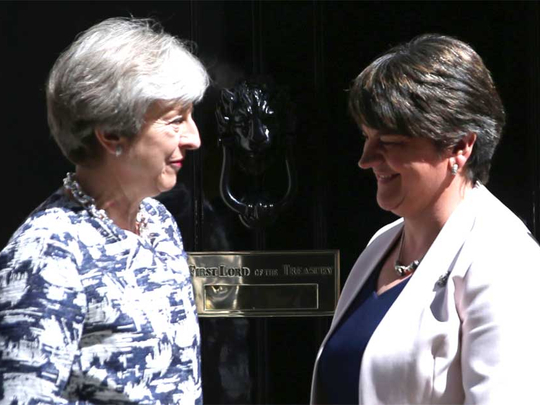
So to the legions of experts required to make any sense of Northern Ireland we may now need to add lexicographers or semioticians. Where does the line, the border as it were, blur between regulatory “non-divergence” and “convergence” and “alignment”?
The European Union-United Kingdom draft agreement that was on the table on Monday, suggests that, in all but name, Northern Ireland would have remained a part of the EU. Achieving the UK government’s agreement on this was a truly momentous achievement for Irish Prime Minister Leo Varadker, derided by the Brexiter ultras as being naive and out of his depth. This has been an international-relations baptism of fire, it is true, but he has come through unscathed. That the British government withdrew its own proposal was, to borrow a phrase once used by the former taoiseach Charles Haughey, “grotesque, unbelievable, bizarre, and unprecedented”. It is now unclear that it will be back on the table, which is a pity as it had the great merit of ambiguity. But the proposal also throws up as many questions as it answers — nothing new in the context of either Northern Ireland or the EU’s dealings with crises.
The relative economic history of the two parts of Ireland has itself two parts. In the first, lasting to the mid-20th century, investment and productivity went north. At partition in 1921, the situation was glaring. Northern Ireland had the industry and an outward orientation. Ireland was predominantly agricultural, and significantly poorer, with an economic policy that moved towards greater levels of autarky in the 1920s and 30s. The contrast since the 1950s is vast. The Irish economy now dwarfs that of the North; it is vastly more export-oriented, even allowing for the over-representation of multinational corporations. In terms of productivity, Northern Ireland lags behind the UK, which itself tends to lag behind the EU, while Ireland is significantly more productive. Belfast is a pleasant, if somewhat provincial, city while Dublin is a vibrant, booming European capital.
The proposed deal has significant issues, however. There is a general consensus in economics that any region trades more with regions geographically close than with regions afar. A small market next door is as valuable or more valuable than a large one far away. This is the iron law of economic gravity. Note that culture mitigates this — distance is both geographical and psychic. The outcome of this is that Ireland, as a goods export destination for the UK is as important as India and China combined.
For Northern Ireland this means that it should trade with both Ireland and with the rest of the UK. And it does. But a report from the Economic and Social Research Institute in 2009 compiled for Intertrade Ireland shows that the existence of the border has been massively damaging to possible trade. Their modelling suggests that north-south trade should be up to 80 per cent higher and south-north trade should be up to 75% greater than currently. In general borders deter trade.
Any move that reduces the border should then result in increased trade flows. This would be a win-win.
A problem, however, emerges when we consider where the EU regulatory and customs border exists. If it does not exist at the present Ireland-UK border then it must be at the Northern Ireland border with the rest of the UK, the Irish Sea. The only way in which this would not happen is if there was no regulatory divergence between the EU (now including Northern Ireland) and the rest of the UK. A core argument for Brexit, however, was to allow the UK as a whole (or, now, in large part) to make its own rules, to drive its own regulations for good or ill. So we cannot have a situation where a lower level of regulations on goods or services in one part is allowed to give a competitive advantage in trade with the other.
Imagine those chlorinated American chickens — if the UK allows them in and the EU refuses, then there must be customs and regulatory checks between Britain and Northern Ireland to prevent these foul fowl seeping into the EU supply chain.
But that is both economically and constitutionally problematic. Economically, while the Northern Ireland traders are realigning southward, they will face non-tariff barriers for their trade with Britain increasing costs. So there is a short-term hit for Northern Ireland business, whether it’s a hard, soft or scrambled Brexit. Constitutionally, a major anomaly is that one part of a single state is treated in a preferential way. It is understandable that the unionists would balk at these problems. That they would have the best of both worlds — economically part of the EU and constitutionally part of the UK — may not be enough to overcome these concerns. But they should. A hard border would, without doubt, be a calamity for the Northern Ireland economy.
That the DUP would wish to foist this on their constituents and on the majority of the population of Northern Ireland who voted to remain in the EU is, to most people, quite bewildering. A poorer Northern Ireland, which will be the case from a hard Brexit, can only bring the day of a constitutionally united Ireland closer. In rejecting this modest proposal the DUP has sacrificed long-term constitutional and economic order on the dark altar of political expediency, and not for the first time.
— Guardian News & Media Ltd
Brian Lucey is professor of Finance at Trinity College Dublin.












